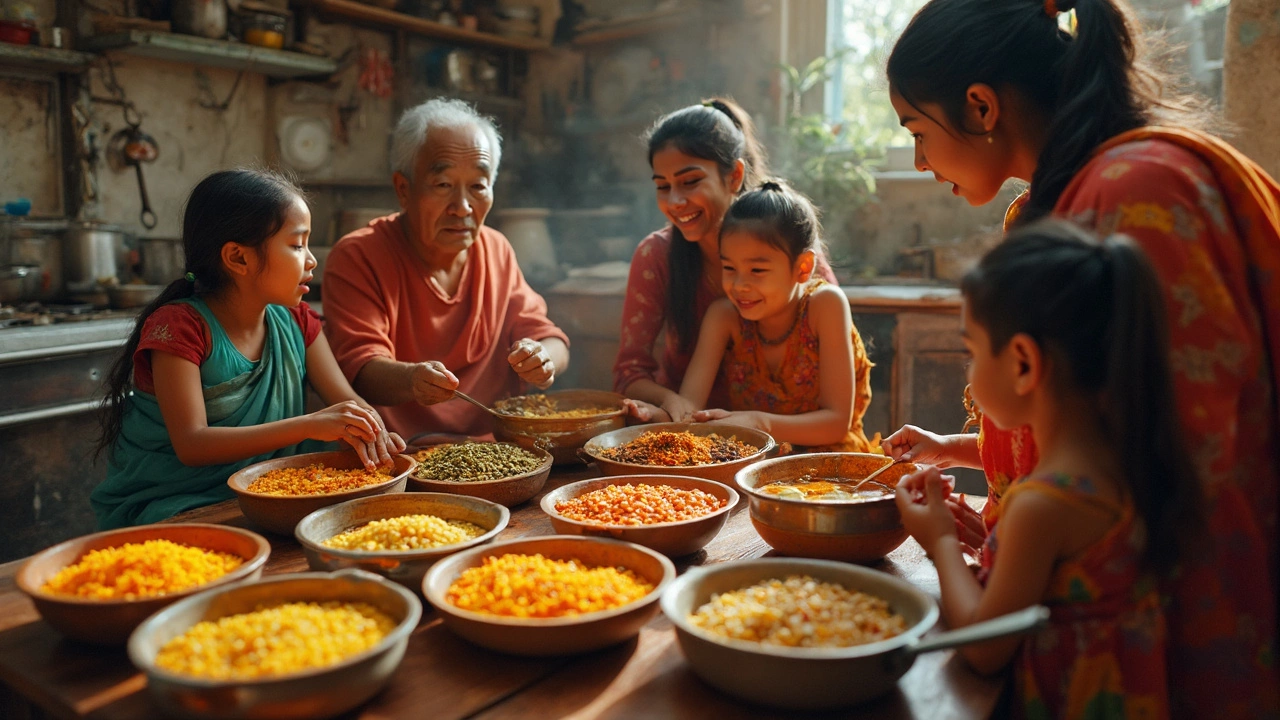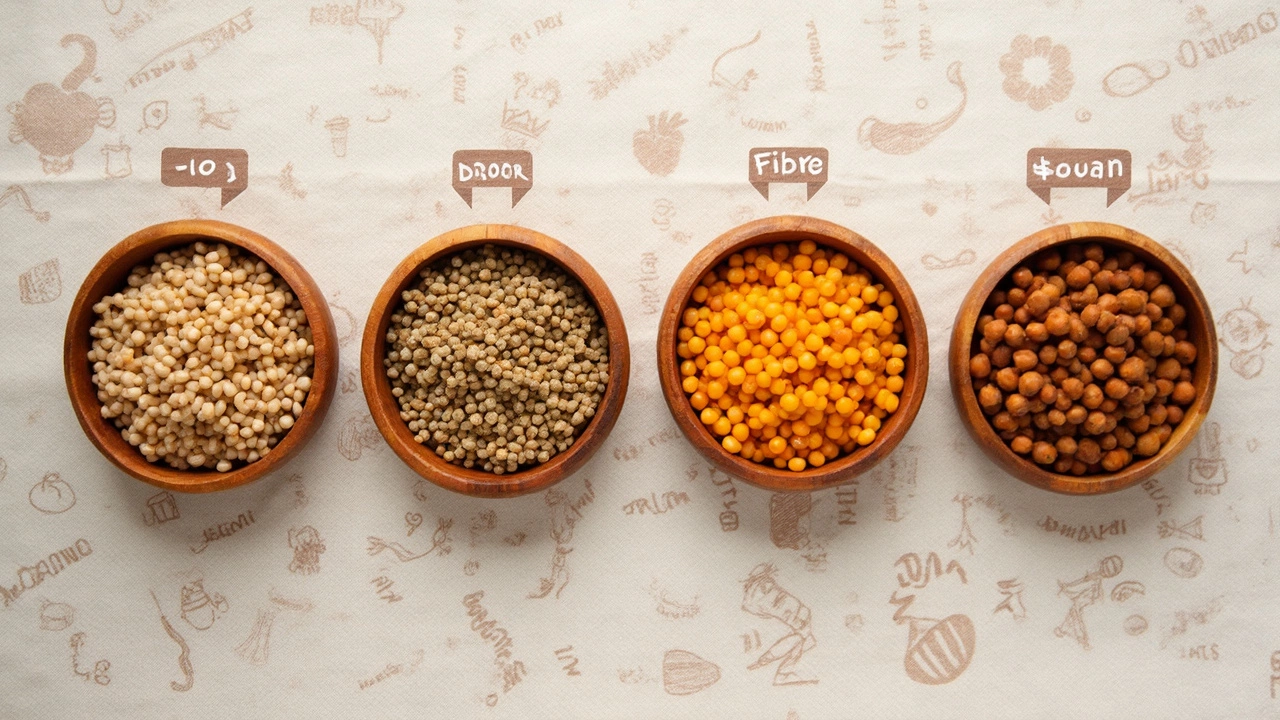Which Dal Is Healthiest? A No-Nonsense Guide for Everyday Meals
 Apr, 22 2025
Apr, 22 2025
Ever found yourself standing in the dal aisle, totally baffled by the options? You’re not alone. Picking the healthiest dal isn’t just about taste—it’s about what your body needs and how you like to eat. Some dals pack more protein, others are a fiber powerhouse, and a few are just easier on your stomach. There’s no single winner, but knowing a bit about each type helps you choose what’s best for dinner tonight.
If you’re watching your protein or need something gentle for digestion, the choice of dal can make a real difference. Moong dal, for example, is super gentle and light—something even hospitals serve because it’s easy to digest. Chana dal packs a punch on protein and keeps you full longer. Masoor dal cooks the quickest (lifesaver on a lazy day), while arhar (toor) dal brings that classic yellow dal flavor with a good mix of nutrients.
Why does all this matter? Because no two dals give you the same benefits. Mixing things up actually helps your body get a bit of everything—more energy, better digestion, steadier blood sugar, and a daily dose of iron and vitamins. Want quick energy or something filling to keep hunger at bay? Your answer is right in one of those dal packets. Next time you reach for a bag, you’ll know exactly what you’re getting—and it’s not just carbs or bland mush in a bowl.
- Dal Nutrition Face-Off: The Healthiest Picks
- Benefits of Popular Dals (Moong, Masoor, Toor, Chana)
- How Cooking Changes Nutrition
- Tips to Get the Most Out of Every Dal
Dal Nutrition Face-Off: The Healthiest Picks
If you’ve ever compared dal packs at the store, you know the choices are endless. So, which one actually tops the health chart? Here’s what you need to know if you want to pick the healthiest dal for your family.
Let’s break down the most popular players:
- Moong Dal: The lightest on the tummy. Super easy to digest, low in fat, and still gives a solid hit of protein. Great for anyone on a diet or with a sensitive stomach—kids, elders, or if you’re just recovering from sickness.
- Masoor Dal: Quick to cook and pretty high in iron. If you’re running low on energy, this red-orange dal can help. It’s not the most protein-rich, but it wins at being practical for busy days.
- Toor/Arhar Dal: A go-to for classic ‘yellow dal’. It’s got a decent protein-fiber combo and is just plain satisfying. Great for steady energy and helping you feel full for longer.
- Chana Dal: The protein boss. Loads of fiber, too. It can keep you full longest, and it’s lower on the glycemic index, so your blood sugar doesn’t spike. If you hit the gym or want to bulk up, this one’s your buddy.
Check out what 100 grams of uncooked dal looks like as far as nutrition goes:
| Dal Type | Protein (g) | Fiber (g) | Iron (mg) | Calories |
|---|---|---|---|---|
| Moong Dal | 24 | 8 | 6 | 347 |
| Masoor Dal | 24 | 11 | 7.5 | 352 |
| Toor Dal | 22 | 10 | 6 | 343 |
| Chana Dal | 21 | 13 | 4.8 | 360 |
Some people swear by moong dal, saying it’s the most versatile and easy to digest, while gym-goers love chana dal for muscle recovery. Here’s the trick: switch things up. Different dals bring a different nutrition punch. Rotating them keeps your meals interesting and your body happy.
Benefits of Popular Dals (Moong, Masoor, Toor, Chana)
Each dal brings its own game when it comes to health. Let’s break down the main contenders—moong dal, masoor dal, toor dal, and chana dal—so you know what works best for your routine meals. Trust me, these aren’t just different colored pulses—they all have something special to offer.
Moong Dal is the go-to for anyone wanting easy digestion. It’s super light on the tummy and perfect for both weight-watchers and people recovering from illness. It’s high in protein (about 24 grams per 100 grams, uncooked), low in fat, and kind to your gut. Plus, it cooks fast—no soaking or long wait needed. If you want a quick, healthy meal, this is your friend. Bonus: it’s packed with antioxidants and gets you decent iron and magnesium.
Masoor Dal (red lentils) is all about quick cooking and energy. It’s got about 22 grams protein per 100 grams, but what sets it apart is the rich iron content—great for anyone fighting fatigue or low hemoglobin. It’s a smart pick for teens, pregnant women, or whenever you need an energy boost. Plus, the fiber helps keep your digestion smooth.
Toor Dal (arhar dal) is probably the most common dal on Indian tables. It’s your typical yellow dal, full of flavor and with a balanced mix of carbs, protein (around 22 grams per 100 grams), and fiber. Since it’s a solid source of folic acid, it’s a strong pick for new moms or anyone watching heart health. Its flavor pairs well with simple tadkas or rich sambar preps.
Chana Dal brings the heavyweight punch of protein (about 21 grams per 100 grams) and is very high in dietary fiber—almost triple that of masoor dal. That means it fills you up and keeps blood sugar steady, so it’s great if you want to avoid those hunger crashes. If you’re watching your weight or have diabetes in the family, it's a smart swap for white rice or rotis once in a while. Plus, it’s loaded with B-vitamins, especially folate and B6—good for energy and nerves.
| Dal Type | Protein (g/100g, uncooked) | Fiber (g/100g, uncooked) | Iron (mg/100g) |
|---|---|---|---|
| Moong Dal | 24 | 8 | 6.7 |
| Masoor Dal | 22 | 8 | 7.6 |
| Toor Dal | 22 | 7 | 5.5 |
| Chana Dal | 21 | 20 | 4.8 |
If you’re going for dal nutrition, here’s a quick tip: use more than one dal in your meals, either by mixing them together or rotating through the week. This way, you aren’t missing out on anything, and your taste buds won’t get bored.

How Cooking Changes Nutrition
How you cook dal makes a bigger difference than you might think. Boiling, pressure-cooking, soaking, or even sprouting—each method tweaks the nutritional profile in its own way. Soaking dal before cooking isn’t just some old-school trick. It helps break down antinutrients like phytic acid, making the protein and iron in your healthiest dal easier for your body to soak up. Plus, soaked dal cooks faster and gets digested more easily, which is a bonus for anyone with a sensitive stomach.
Pressure-cooking is the go-to in most Indian kitchens because it saves time and energy. Here’s the catch: cooking dal at super high heat for a long time can lower the levels of certain B vitamins. But the good news is, you probably get enough B vitamins from veggies, grains, or even a squeeze of lemon, so it’s not a huge worry unless dal is your only source.
- Slow simmering preserves flavor and most nutrients, but takes more time.
- Boiling dal and discarding the water? That can drain away minerals and water-soluble vitamins, so always cook with just enough water and keep it all in your dish.
- Adding turmeric, ginger, or garlic when cooking doesn’t just boost flavor. These add antioxidants—and even help you absorb more iron from dal.
Curious about nutrient loss? Here’s a practical look at how popular cooking methods change dal’s nutrition:
| Method | Prep Time | Protein Retention | B Vitamin Retention |
|---|---|---|---|
| Raw, Soaked | 6-8 hrs soak | 100% | 100% |
| Pressure-cooked | 10-15 min | 95% | 80-85% |
| Boiled (open pot) | 30-40 min | 95% | 85-90% |
If you want the most from every bowl, soak your dal for a few hours, cook it with the lid tight, and don’t toss the cooking water. Use a pressure cooker for a quick meal, but keep the heat just enough to soften the dal—don’t overdo it. These simple hacks make the nutrition in your dal recipe simple go further each time.
Tips to Get the Most Out of Every Dal
Using dal the right way makes a huge difference to your meals and your health. If you want all the nutrition and taste, a few tweaks in how you cook and serve your dal can help you get the best out of every bowl.
- Always rinse dal thoroughly before cooking—it gets rid of dust, excess starch, and any preservatives. This single step already makes your dal lighter and easier to digest.
- Soak dal for at least 30 minutes before cooking. This makes it softer, reduces cooking time, and even unlocks more nutrients, especially iron and zinc.
- Rotate between moong, masoor, toor, and chana dals during the week. Each type offers unique benefits—a mix of dal nutrition means your body doesn’t miss out on any important vitamins or minerals.
Want more protein from your healthiest dal? Pair it with a small portion of rice or wheat roti. The combination gives your body all the essential amino acids for better muscle repair and energy. Moong dal and rice is a classic combo for this reason.
Don’t just cook dal in plain water. Throw in a pinch of turmeric (for better immunity) and a bit of hing (asafoetida) or ginger, which cuts down gas and makes the meal gentler on your stomach.
- Keep the skin on when possible, especially for moong or masoor dal. The skin boosts the fiber content, soaks up water, and keeps you full for longer.
- If you’re after more iron and folic acid—don’t drain the water after boiling dal. The nutrients often leak into the cooking water, so use it all up in your curry or soup.
Here’s a quick look at how nutrients stack up in common dals per 100g (raw):
| Dal | Protein (g) | Fiber (g) | Iron (mg) |
|---|---|---|---|
| Moong (split, skinned) | 24 | 8 | 4.4 |
| Masoor (red lentil) | 25.1 | 10 | 6.5 |
| Toor (arhar) | 22.3 | 8 | 2.6 |
| Chana dal | 25 | 11 | 4.8 |
For a boost in flavor and nutrition, don’t forget those tadka add-ons—garlic, curry leaves, cumin, and mustard seeds. They add not just taste but anti-inflammatory effects and digestion support too.